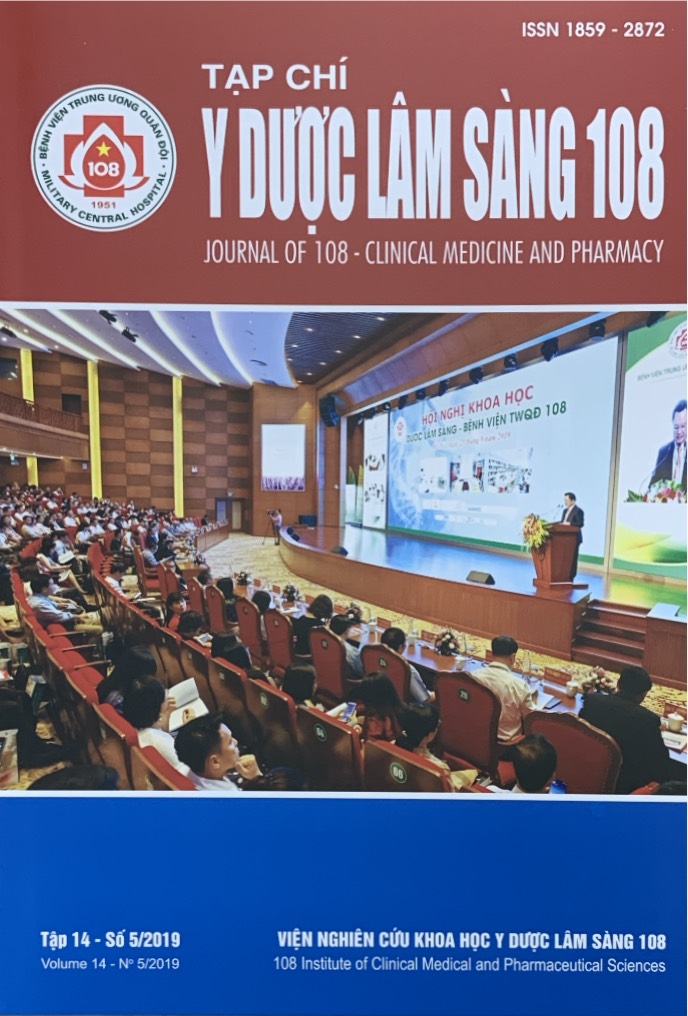Evaluation of technical characteristics, safety and some related factors of hemoclips alone and hemoclips combined adrenalin 1/10,000 in treatment of peptic ulcer bleeding
Main Article Content
Keywords
Abstract
Objective: Evaluation of technical characteristics, safety and some related factors of hemoclips alone and hemoclips combined adrenalin 1/10,000 in treatment of peptic ulcer bleeding. Subject and method: 150 patients were randomized into 2 groups: Group I: Clip alone (n = 75) and group II: Clip + adrenalin 1/10,000 (n = 75). All patients received inpatient treatment, clinical and paramclinical examination and upper gastrointestinal endoscopy. Parameters established relationship: Clinical Rockall, full Rockall and Blatchford. Result: There were no serious complications after treatment between group I and II (p>0.05). The number of clips used in group I was: 2.07 ± 0.827, in group II: 2.19 ± 1.087, the difference was not statistically significant (p=0.448). Clinical Rockall, full Rockall and Blatchford score increased significantly higher in patients with gastric ulcer versus duodenal ulcer (p<0.05). Clinical Rockall, full Rockall and Blatchford score increased significantly higher in patients with blood transfusions than patients without blood transfusions (p<0.001). Conclusion: There are no serious complications after endoscopic treatment. Clinical Rockall, full Rockall and Blatchford score are related to blood transfusion, gastro-duodenal ulcer location.
Article Details
References
2. Hội nghị Khoa học Tiêu hóa Việt Nam (2009) Khuyến cáo xử trí xuất huyết tiêu hóa trên cấp tính không do tăng áp lực tĩnh mạch cửa. Tạp chí khoa học tiêu hóa Việt Nam, tập IV, số 17, tr. 1178-1192.
3. Lê Quang Đức (2017) Nghiên cứu kết quả điều trị chảy máu do loét dạ dày tá tràng bằng phương pháp điện đông lưỡng cực đơn thuần và phối hợp tiêm dung dịch adrenalin 1/10.000 qua nội soi. Luận án Tiến sỹ Y học, Học viện Quân y.
4. Rockall TA, Logan RF, Devlin HB, Northfield TC (1996) Risk assessment after acute upper gastrointestinal haemorrhage. Gut 38(3): 316-322.
5. Blatchford O, Murray WR, Blatchford M (2000) A risk score to predict need for treatment for upper-gastrointestinal haemorrhage. Lancet 356: 1318-1132.
6. Siau K, Chapman W, Sharma N et al (2017) Management of acute upper gastrointestinal bleeding: An update for the general physician. Journal of the Royal College of Physicans of Edinburgh 47(3): 218-230.
7. Barkun A, Bardou M, Kuipers E et al (2010) International consencus recommendations on the management of patients with non variceal upper gastrointestinal bleeding. Ann Intern Med 152: 101-113.
8. Lin HJ, Hsieh YH, Tseng GY et al (2002) A prospective, randomized trial of large-versus small-volume endoscopic injection of epinephrine for peptic ulcer bleeding. Gastrointest Endosc 55: 615-619.
9. Liou TC, Lin SC, Wang HY, Chang WH (2006) Optimal injection volume of epinephrine for endoscopic treatment of peptic ulcer bleeding. World J Gastroenterol 12(19): 3108-3113.
10. Ljubicic N, Budimir N, Biscanin A et al (2012) Endoclips vs large or small-volume epinephrine in peptic ulcer recurrent bleeding. World J Gastroenterol 18(18): 2219-2222.
11. Park CH, Lee SJ, Park JH et al (2004) Optimal injection volume of epinephrine for endoscopic prevention of recurrent peptic ulcer bleeding. Gastrointest Endosc 60: 875-880.
 ISSN: 1859 - 2872
ISSN: 1859 - 2872
